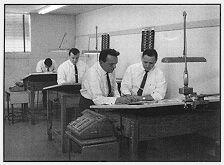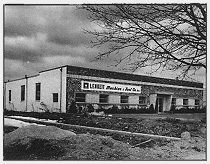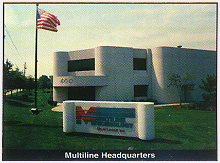|
The Story of Multiline Technology
Multiline
is proud to be celebrating its twentieth anniversary this year. The company
which evolved into Multiline Technology, started over sixty years ago
in a 15’ x 60’ small storefront on Gates Avenue in Brooklyn,
New York. In 1936 Hans Lenkeit started a small tool and die company which
carried his name, Lenkeit Machine and Tool Company, which specialized
in precision watch parts. In 1942 all its efforts were devoted to the
manufacture of parts for the military during World War II.
After the war Lenkeit moved to Long Island under the direction of two
skilled tool and die makers, Hans’ son Bill and Fred Angelo (ret.
Chairman) who was the shop foreman. Although the company was now predominately
building compacting dies for the ceramic industry and progressive dies
for metal stamping, Fred Angelo recalls the day a few people came to see
him from a small company on Long Island and asked him to build a die to
punch holes in and blank out a printed circuit board. This small start
up company, Photocircuits, quickly became Lenkeit’s best customer
and soon circuit board dies started to dominate the workload. As the circuit
board industry grew so did Lenkeit’s business and reputation as the
leading manufacturer of PCB dies in the country.
 
In the mid sixties, under the direction of the company’s President,
Fred Angelo, the company again moved to larger quarters and made some
significant equipment purchases with the first wire EDM (electrical discharge
machining) installed in the area (Long Island) and precision jig grinding
equipment which enabled the tool room to position holes within 0.0001
(one ten thousandth of an inch)of an inch (i.e.; the human hair is approximately
.003” (three thousandths of an inch). This expanded the company’s
capability which was timed perfectly for the next tooling challenge, “Flexcircuits”.
Special flexible circuits which are used for disc reading and similar
applications have stringent requirements on edge quality and can not be
stamped out using conventional steel rule dies. Very tight clearance punch
and dies are necessary to meet these needs. This not only required machining
skills but extensive hand fitting which can only be done by accomplished
tool makers. Fortunately for IBM, Rogers and Buckbee Mears , Lenkeit was
well staffed with these skills. Around this time Lenkeit also started
building lamination plates for its customers who were experimenting with
the relatively new business of laminating multilayers.
 
In 1978, at the urging of our customers, Lenkeit designed and built the
first Multilayer tooling hole punch , the “Acculine”. Until
the introduction of the Acculine the circuit board manufacturers who were
making multilayers were either drilling in the tooling holes or using
large fixed tooling hole dies in very large punch presses. The advantage
of the Acculine was that it was adjustable from 9” X 9” to 24”
X 24” on ½ inch increments. This was extremely important back
in 1978 since most companies were just getting into the multilayer business
and were not yet standardized on any particular panel sizes.
The most significant contribution of Lenkeit/Multiline at that time was
the introduction of the 4 slot tooling system as a standard for the industry.
The 4 slot system of registration was already being used in the graphic
arts industry with great success. Realizing the need for a tooling system
which would compensate for the poor dimensional stability of artwork and
laminate and also eliminate problems in lay up and drilling, the 4 slot
system was incorporated into the first Acculine and the standard was set.
Today nearly every manufacturer of multilayers throughout the world have
their tooling based around the original 10-D068 print issued for that
first job with 4 -slot configuration.
 
In late 1979 it became obvious that the growth in the circuit board industry
was going to be in Multilayers. Lenkeit Industries spun off a small machine
building division and called it Multiline Technology. It was not long
before Multiline surpassed the tool and die division in sales. It also
became obvious to management that the skills of the tool makers were better
utilized on the new Multilayer equipment. More products were being introduced,
again at the requests of our fast growing lists of customers, including
Depinners, Lay-Up Stations, Artwork Punches and all types of accessories
needed for lamination. Then in 1984 a major milestone for the new Multiline
Technology occurred, the introduction of the Post Etch Punch.
The Post Etch Punch came about thanks to the persistance of one of Multiline’s
flexible circuit customers who wanted to use the artwork punch to punch
innerlayers. Their reasoning was that the material moved so much that
if they could punch after etching it would greatly improve registration
since material movement would then be compensated for. Recognizing a potentially
good idea, Multiline went to their customers and found that this problem
was even more pronounced in Multilayers due to the stack up of layers
of different constructions. The Optiline PE was born and within a few
years it was the recognized standard in the Multilayer industry for registering
and punching innerlayers.
 
In the late eighties the need to support our growing list of customers
in Europe dictated the need to start a sales and service organization
there. An area outside of Frankfurt was selected and Multiline International
Europa was started. Today MIE has a staff of thirty people split between
sales, service and customer support.
The next major development for Multiline came with the acquisition of
Loma Park Associates x-ray technology. This was the first x-ray machine
offered which combined the diagnostics of x-ray into a production piece
of printed circuit board equipment. Multiline used its tooling expertise
to transform the somewhat difficult to use Loma Park Optimizer into a
high volume production tool. In 1995 a totally new redesigned x-ray tooling
unit was introduced, the Optiline PL (post lamination drill). Since the
introduction of the OPL we have strived to improve the performance of
these machines and now have through-puts mprove the performance of these
machines and now have through-puts which exceed five panels per minute.
In 1999 the x-ray line of equipment was expanded to include the XRT-1000,
a lower cost slightly slower machine for smaller volume shops.
 
Multiline Technology’s 20th anniversary was appropriately the best
year in Multiline history. Sales were the highest we have ever had, another
10,000 square feet of manufacturing space was added, and a new very successful
product (glass tooling frames) was launched.
The future of Multiline has and will always be customer service and
satisfaction. It is our overall commitment to listen to our customers
needs and design registration tooling solutions to meet those needs. Working
closely with our customers, Multiline uses Applications Engineering and
R&D resources to develop products that meet both the performance and
the market goals of its customers. We at Multiline Technology look forward
to having the opportunity to be of (continued) service to you and your
company.
|
|
Fred Angelo (Chairman) having discussions
with engineering personnel
|
|
|
Farmingdale,N.Y. Route 110 location
1964 to 1985 13,000 Square feet
|
|
|
1986 to Present 36,000 Square feet
also located in Farmingdale,N.Y.
|
Home | About Us | Staff | Directions | Products | News | Trade Shows | Literature | Employment | Contact Us
© 2002 Multiline Technology
|













